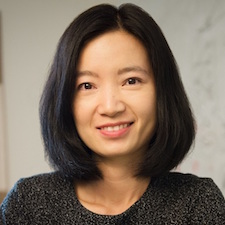Introduction
There is a great deal of interest in analyzing data that is best represented as a graph.
Examples include the WWW, social networks, biological networks, communication networks,
transportation networks, energy grids, and many others. These graphs are typically
multi-modal, multi-relational and dynamic. In the era of big data, the importance of being
able to effectively mine and learn from such data is growing, as more and more structured
and semi-structured data is becoming available. The workshop serves as a forum for
researchers from a variety of fields working on mining and learning from graphs to share and
discuss their latest findings.
There are many challenges involved in effectively mining and learning from this kind of
data, including:
- Understanding the different techniques applicable, including graph mining algorithms, network embeddings, graphical models, latent variable models, matrix factorization methods and more.
- Dealing with the heterogeneity of the data.
- The common need for information integration and alignment.
- Handling dynamic and changing data.
- Addressing each of these issues at scale.
Traditionally, a number of subareas have contributed to this space: communities in graph mining, learning from structured data, statistical relational learning, inductive logic programming, and, moving beyond subdisciplines in computer science, social network analysis, and, more broadly network science.
Schedule
Washington DC Convention Center - 207A
-Held jointly with Workshop on Deep Learning on Graphs (KDD-DLG)-
| Morning Sessions | |
|---|---|
| 8:30-8:45am | Opening Remarks |
| 8:45-9:30am |
Keynote: Jiawei Han Towards Automatic Construction of Text-Rich Information Networks from Text |
| 9:30-10:00am | Break and Poster Setup |
| 10:00-10:45am |
Keynote: Neil Shah Scaling up Graph Neural Networks at Snap |
| 10:45-11:15am | Contributed Talks Christopher Musco et al. How to Quantify Polarization in Models of Opinion Dynamics Jiaqi Ma et al. Partition-Based Active Learning for Graph Neural Networks |
| 11:15-12:00pm |
Panel: Jiawei Han, Lingfei Wu, Xiaojie Guo, Neil Shah, Tim Weninger Learning and Reasoning on Knowledge Graphs: Graph Neural Networks vs Foundation Models |
12:00-1:30pm | Lunch Break |
| Afternoon Sessions | |
|---|---|
| 1:30-2:15 pm |
Keynote: Yizhou Sun Combining Representation Learning and Logical Rule Reasoning for Knowledge Graph Inference |
| 2:15-2:45 pm | Contributed Talks Yu Shi et al. mvn2vec: Preservation and Collaboration in Multi-View Network Embedding John Palowitch et al. Robust Synthetic GNN Benchmarks with GraphWorld |
| 2:45-3:30 pm | Break and Poster Session |
| 3:30-4:15 pm |
Keynote: Jennifer Neville Social reinforcement learning for optimizing network-level goals in multi-agent systems |
| 4:15-4:45pm | Closing Remarks |
Keynote Speakers

Jiawei Han
Professor
UIUC

Jennifer Neville
Senior Principal Researcher/Professor
Microsoft/Purdue

Yizhou Sun
Associate Professor
UCLA

Neil Shah
Lead Research Scientist
Snap Inc.
Accepted Papers
ColdGuess: A General and Effective Relational Graph Convolutional Network to Tackle Cold Start Cases
PDF
Bo He, Xiang Song, Christos Faloutsos and Vincent Gao
title={ColdGuess: A General and Effective Relational Graph Convolutional Network to Tackle Cold Start Cases},
author={Bo He, Xiang Song, Christos Faloutsos and Vincent Gao},
booktitle={Proceedings of the 17th International Workshop on Mining and Learning with Graphs (MLG)},
year={2022}
}
How to Quantify Polarization in Models of Opinion Dynamics
PDF
Christopher Musco, Indu Ramesh, Johan Ugander and R. Teal Witter
title={How to Quantify Polarization in Models of Opinion Dynamics},
author={Christopher Musco, Indu Ramesh, Johan Ugander and R. Teal Witter},
booktitle={Proceedings of the 17th International Workshop on Mining and Learning with Graphs (MLG)},
year={2022}
}
Tailored vertex ordering for faster triangle listing in large graphs
PDF
Fabrice Lécuyer, Louis Jachiet, Clémence Magnien and Lionel Tabourier
title={Tailored vertex ordering for faster triangle listing in large graphs},
author={Fabrice Lécuyer, Louis Jachiet, Clémence Magnien and Lionel Tabourier},
booktitle={Proceedings of the 17th International Workshop on Mining and Learning with Graphs (MLG)},
year={2022}
}
Knowledge-aware Neural Collective Matrix Factorization for Cross-domain Recommendation
PDF
Li Zhang, Yan Ge, Jun Ma, Jianmo Ni and Haiping Lu
title={Knowledge-aware Neural Collective Matrix Factorization for Cross-domain Recommendation},
author={Li Zhang, Yan Ge, Jun Ma, Jianmo Ni and Haiping Lu},
booktitle={Proceedings of the 17th International Workshop on Mining and Learning with Graphs (MLG)},
year={2022}
}
OASYS: Domain-Agnostic Automated System for Constructing Knowledge Base from Unstructured Text
PDF
Minsang Kim, Sanghyun Je and Eunjoo Park
title={OASYS: Domain-Agnostic Automated System for Constructing Knowledge Base from Unstructured Text},
author={Minsang Kim, Sanghyun Je and Eunjoo Park},
booktitle={Proceedings of the 17th International Workshop on Mining and Learning with Graphs (MLG)},
year={2022}
}
Semi-Supervised Node Classification on Graph via Inconsistent Nodes Correction
PDF
Shuhao Shi, Jian Chen, Kai Qiao, Shuai Yang, Linyuan Wang and Bin Yan
title={Semi-Supervised Node Classification on Graph via Inconsistent Nodes Correction},
author={Shuhao Shi, Jian Chen, Kai Qiao, Shuai Yang, Linyuan Wang and Bin Yan},
booktitle={Proceedings of the 17th International Workshop on Mining and Learning with Graphs (MLG)},
year={2022}
}
Graph-Assisted Tensor Disaggregation
PDF
Mariana Duarte, Evangelos Papalexakis and Jia Chen
title={Graph-Assisted Tensor Disaggregation},
author={Mariana Duarte, Evangelos Papalexakis and Jia Chen},
booktitle={Proceedings of the 17th International Workshop on Mining and Learning with Graphs (MLG)},
year={2022}
}
Attributed Labeled BTER-Based Generative Model for Benchmarking of Graph Neural Networks
PDF
Polina Andreeva, Egor Shikov and Claudie Bocheninа
title={Attributed Labeled BTER-Based Generative Model for Benchmarking of Graph Neural Networks},
author={Polina Andreeva, Egor Shikov and Claudie Bocheninа},
booktitle={Proceedings of the 17th International Workshop on Mining and Learning with Graphs (MLG)},
year={2022}
}
Learning Personalized Representations using Graph Convolutional Network
PDF
Hongyu Shen, Jinoh Oh, Shuai Zhao, Guoyin Wang, Tara Taghavi and Sungjin Lee
title={Learning Personalized Representations using Graph Convolutional Network},
author={Hongyu Shen, Jinoh Oh, Shuai Zhao, Guoyin Wang, Tara Taghavi and Sungjin Lee},
booktitle={Proceedings of the 17th International Workshop on Mining and Learning with Graphs (MLG)},
year={2022}
}
Distance-wise Prototypical Graph Neural Network for Imbalanced Node Classification
PDF
Yu Wang, Charu Aggarwal and Tyler Derr
title={Distance-wise Prototypical Graph Neural Network for Imbalanced Node Classification},
author={Yu Wang, Charu Aggarwal and Tyler Derr},
booktitle={Proceedings of the 17th International Workshop on Mining and Learning with Graphs (MLG)},
year={2022}
}
Understanding Self-Supervised Graph Representation Learning from a Data-Centric Perspective
PDF
Puja Trivedi, Ekdeep Singh Lubana, Mark Heimann, Danai Koutra and Jayaraman Thiagarajan
title={Understanding Self-Supervised Graph Representation Learning from a Data-Centric Perspective},
author={Puja Trivedi, Ekdeep Singh Lubana, Mark Heimann, Danai Koutra and Jayaraman Thiagarajan},
booktitle={Proceedings of the 17th International Workshop on Mining and Learning with Graphs (MLG)},
year={2022}
}
Coarsen, Align, Project, Refine - A General Multilevel Framework for Network Alignment
PDF
Jing Zhu, Danai Koutra and Mark Heimann
title={Coarsen, Align, Project, Refine - A General Multilevel Framework for Network Alignment},
author={Jing Zhu, Danai Koutra and Mark Heimann},
booktitle={Proceedings of the 17th International Workshop on Mining and Learning with Graphs (MLG)},
year={2022}
}
Fast and Efficient n-Metrics for Multiple Graphs
PDF
Kimia Shayestehfard, Dana Brooks and Stratis Ioannidis
title={Fast and Efficient n-Metrics for Multiple Graphs},
author={Kimia Shayestehfard, Dana Brooks and Stratis Ioannidis},
booktitle={Proceedings of the 17th International Workshop on Mining and Learning with Graphs (MLG)},
year={2022}
}
Ethereum Fraud Detection with Heterogeneous Graph Neural Networks
PDF
Hiroki Kanezashi, Toyotaro Suzumura, Xin Liu and Takahiro Hirofuchi
title={Ethereum Fraud Detection with Heterogeneous Graph Neural Networks},
author={Hiroki Kanezashi, Toyotaro Suzumura, Xin Liu and Takahiro Hirofuchi},
booktitle={Proceedings of the 17th International Workshop on Mining and Learning with Graphs (MLG)},
year={2022}
}
mvn2vec: Preservation and Collaboration in Multi-View Network Embedding
PDF
Yu Shi, Fangqiu Han, Xinwei He, Xinran He, Carl Yang, Luo Jie and Jiawei Han
title={mvn2vec: Preservation and Collaboration in Multi-View Network Embedding},
author={Yu Shi, Fangqiu Han, Xinwei He, Xinran He, Carl Yang, Luo Jie and Jiawei Han},
booktitle={Proceedings of the 17th International Workshop on Mining and Learning with Graphs (MLG)},
year={2022}
}
Call for Papers
This workshop is a forum for exchanging ideas and methods for mining and learning with graphs, developing new common understandings of the problems at hand, sharing of data sets where applicable, and leveraging existing knowledge from different disciplines. The goal is to bring together researchers from academia, industry, and government, to create a forum for discussing recent advances in graph analysis. In doing so, we aim to better understand the overarching principles and the limitations of our current methods and to inspire research on new algorithms and techniques for mining and learning with graphs.
To reflect the broad scope of work on mining and learning with graphs, we encourage submissions that span the spectrum from theoretical analysis to algorithms and implementation, to applications, empirical studies and reflection papers. As an example, the growth of user-generated content on blogs, microblogs, discussion forums, product reviews, etc., has given rise to a host of new opportunities for graph mining in the analysis of social media. More recently, the advent of neural methods for learning graph representations has spurred numerous works in embedding network entities for diverse applications including ranking and retrieval, traffic routing and drug-discovery. We encourage submissions on theory, methods, and applications focusing on a broad range of graph-based approaches in various domains.
Topics of interest include, but are not limited to:
- Theoretical aspects:
- Computational or statistical learning theory related to graphs
- Theoretical analysis of graph algorithms or models
- Sampling and evaluation issues in graph algorithms
- Analysis of dynamic graphs
- Algorithms and methods:
- Graph mining
- Probabilistic and graphical models for structured data
- Heterogeneous/multi-model graph analysis
- Graph neural networks and graph representation learning
- Statistical models of graph structure
- Combinatorial graph methods
- Semi-supervised learning, active learning, transductive inference, and transfer learning in the context of graph
- Applications and analysis:
- Analysis of social media
- Analysis of biological networks
- Knowledge graph construction
- Large-scale analysis and modeling
We welcome many kinds of papers, such as, but not limited to:
- Novel research papers
- Demo papers
- Work-in-progress papers
- Visionary papers (white papers)
- Appraisal papers of existing methods and tools (e.g., lessons learned)
- Evaluatory papers which revisit validity of domain assumptions
- Relevant work that has been previously published
- Work that will be presented at the main conference
Authors should clearly indicate in their abstracts the kinds of submissions
that the papers belong to, to help reviewers better understand their contributions.
All papers will be peer reviewed, single-blinded.
Submissions must be in PDF, no more than 8 pages long — shorter papers are
welcome — and formatted according to the standard double-column ACM
Proceedings Style.
The accepted papers will be published on the workshop’s website and will not be considered
archival for resubmission purposes.
Authors whose papers are accepted to the workshop will have the opportunity to participate
in a spotlight and poster session, and some set will also be chosen for oral presentation.
For paper submission, please proceed to the submission website.
Please send enquiries to chair@mlgworkshop.org.
To receive updates about the current and future workshops and the Graph Mining community, please join the Mailing List, or follow the Twitter Account.
Important Dates
Paper Submission Deadline: May 26, 2022
Author Notification: June 20, 2022
Camera Ready: July 9, 2022
Workshop: August 15, 2022
Workshop Organizers

Shobeir Fakhraei
Senior Applied Scientist
Amazon

Tim Weninger
Associate Professor
Uni. of Notre Dame

Neil Shah
Lead Research Scientist
Snap Inc.

Sami Abu-el-haija
Senior Scientist
Google Research

Saurabh Verma
Research Scientist
Meta Research

Tara Safavi
Research Scientist
Microsoft Research
Program Committee
Ana Paula Appel (IBM Research Brazil)
David Arbour (Adobe)
Ulf Brefeld (Leuphana Universität Lüneburg)
Marco Bressan (University of Milan)
Ivan Brugere (University of Illinois at Chicago)
Hocine Cherifi (University of Burgundy)
Tyler Derr (Vanderbilt University)
Alessandro Epasto (Google)
David Gleich (Purdue University)
Stratis Ioannidis (Northeastern University)
Noah Lee (Facebook)
Jundong Li (University of Virginia)
Yozen Liu (University of Southern California)
John Palowitch (Google)
Evangelos Papalexakis (University of California Riverside)
Ali Pinar (Sandia National Laboratories)
Jan Ramon (INRIA)
Bhavtosh Rath (University of Minnesota -Twin Cities)
Sucheta Soundarajan (Syracuse University)
Stefan Wrobel (Fraunhofer IAIS & Univ. of Bonn)
Shichang Zhang (University of California, Los Angeles)
Lingxiao Zhao (Carnegie Mellon University)
Tong Zhao (Snap Inc.)
Previous Workshops
2020, Virtual (co-located with KDD) 2019, Anchorage, USA (co-located with KDD) 2018, London, United Kingdom (co-located with KDD) 2017, Halifax, Nova Scotia, Canada (co-located with KDD) 2016, San Francisco, USA (co-located with KDD) 2013, Chicago, USA (co-located with KDD) 2012, Edinburgh, Scotland (co-located with ICML) 2011, San Diego, USA (co-located with KDD) 2010, Washington, USA (co-located with KDD) 2009, Leuven, Belgium (co-located with SRL and ILP) 2008, Helsinki, Finland (co-located with ICML) 2007, Firenze, Italy 2006, Berlin, German (co-located with ECML and PKDD) 2005, Porto, Portugal, October 7, 2005 2004, Pisa, Italy, September 24, 2004 2003, Cavtat-Dubrovnik, Croatia